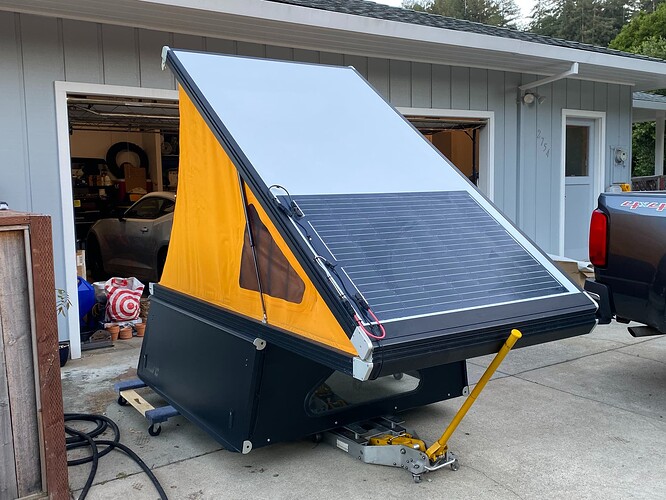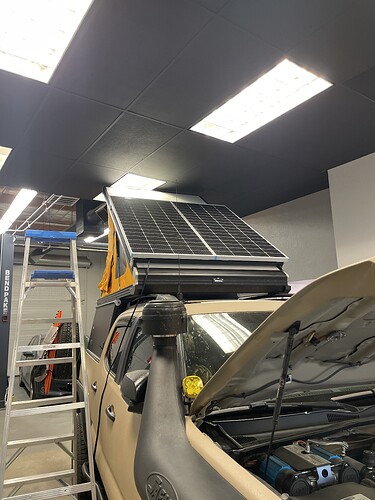Yea I made a harness to connect the two from left over 8 gauge cable I cut down from the 30 fr piece I bought to run the line from the roof top to my goal zero in the bed. You can buy the plug kit from Amazon too, I think it was around $20.
It’s been running flawlessly since I installed it 2 years ago. The 2 panels are run to a 1000x goal zero, and my ICECO JL42 fridge runs constantly off it. At the end of the day I’m always at 100%, by the next morning I’m at 90%, or so. A big thing is to keep the fridge semi full so that it’s not constantly trying to keep the empty space cold.
I solved this by making my own harness with plug oriented as I needed without crossing colored cables.
I advise against doing what I did, which was to affix a Sunflare Xplor panel directly to the composite roof panel. When this panel is getting sun, it transfers so much heat to the interior. You really do want an air gap between your panel and the camper roof.
There really is no way to do this with flexible panels. The alternative would be mounting panels on the beef bars.
There was a thread (could he this one) where someone calculated the heat transfer with the panels.
Just invest in a fan next.
P.s. I have 2 panels like yours that I will be using for solar on my camper.
I almost did that too, but I did remember how hot it got when I laid portable panels on my roof. So I opted for beef racks with panels so I can get that air gap for better cooling.
Yeah, I imagine the air gap + shade from panels could actually help keep the tent cooler than without anything on the roof. has anyone confirmed if that’s true?
You could mount the flexible panels on any sheet (wood, composite, metal) and then mount that to a bar/rack system. The heat transfer really made summer camping worse.
I highly recommend installing hard panels with at least a 1" airgap.
I have flexible panels mounted directly to the roof and they transmit a ton of heat into the camper. One has already died from overheating. I regret my choices. Just this weekend I was in the mountains and you could feel the heat radiating from the panels. It’s not subtle.
This summer I am going to take these same panels, create a hard frame, and mount them at least 1" off the roof, maybe more.
Hey @Dnykrk , which panels are these?
These are the renogy 200W panels. So total 400W.
The other downside of mounting panels without an airgap is the increased panel temp that will not only prematurely degrate the panel over time, but also degrade the voltage in direct sunlight as the panel gets hotter. Heat kills panels, which is why the hood mounted panels make zero sense to me. If you wanted to use a flexible panel while retaining an air gap, you could use wide parallels strips of 3M Dual Lock, or a similar industrial velcro. This way you don’t add extra resistance when driving down the road since air has a path to move between the panel and rooftop. Surface prep is the biggest factor for that though.
Tagging @Eisenheim also…
I have a hood mounted panel on my taco and I have not experienced any heat-related effects as far as loss in voltage. I’ve had it mounted for almost 2 years I think.
However roof mounting my flexible panels (have yet to do so) is worrisome as I had a vinyl wrap that has since succumbed to cracking (likely due to the constant sun and heat-related issues of not being garage kept). I have since removed it.
Per LENSUN SOLAR manufacturer specs (hood and roof panels are same mfg) the ‘ETFE’ construction of the panels are ‘heat resistant’ and also ‘dissipate heat more’ compared to ‘PTE’ constructed panels.
I firmly believe the mattress insulation also plays a role in roof temperatures (when RTT is closed).
Once I complete my bed build out/storage/drawer system I can install the roof solar panels and have first hand knowledge/experience.
I didn’t mean that it wouldn’t work, I just mean that it will degrade quicker over time than regular panels you see out and about mainly because of the heat/heat cycling. But maybe they’ve figured out a way to kinda insulate most of the heat from the panel. I know CIGS panels are extremely tough, but it comes at a trade off of poor efficiency compared to some other forms of solar panels.
As for your wrap, thats a bummer and kinda wild that its already started cracking. The mattress makes 100% sense as far as insulating and trapping heat. I wonder if a reflective wrap on the roof would help manage the heat any better, like a foil/mylar lined wrap.
That seems to be another issue that would deter people from using the flexible solar panels.
To me it seems like it would be a hassle to replace/swap them out when they are fastened to the roof of the GFC using adhesive. I went with Z brackets attaching mine to my DIY beef bars. There’s at least an inch air gap between the GFC roof and the bottom of my panels.
I consider the roof mounted panel because I use my racks on an almost daily basis. I didn’t realize they made the tent hotter though.
You could mount them to corrugated plastic, I think a lot of people do that.
I was checking out this guys video and was wondering why you couldn’t just glue to the corrugated material to create an air flow channel and then glue that to the top of your camper and save yourself the steps of adding the aluminum rail. My 2 cents if you’re just trying to get the heat up off your camper and provide more air flow.
I’m pretty sure I’ve seen people do that. Attach solar panel to corrugated plastic panels and then vhb tape those to the roof. This also makes replacing the panel easier if/when you need to do that.
I know my build thread is like 100 posts long, but I actually tested that, here’s the post on corrugated plastic, multiple layers of corrugated material were worse than a simple air gap.
Maybe if your corrugated material had very deep (close to 1") corrugations…
¯\__(ツ)_/¯
I have used the 3m VHB on my hood mounted panel. For the first 2 years I never had any issues with the tape/panel separating from the hood.
At some point the panel just decided to stop working for whatever reason. It was replaced under warranty.
I used that time to vinyl wrap my hood and attached the new panel with the same vhb.
Let me tell you that using double strips around the perimeter of the panel plus a double strip down the middle was a B**** to remove the panel AND the adhesive residue after.
In my experience vhb adheres to surfaces better with heat.
Just my $0.02 though

